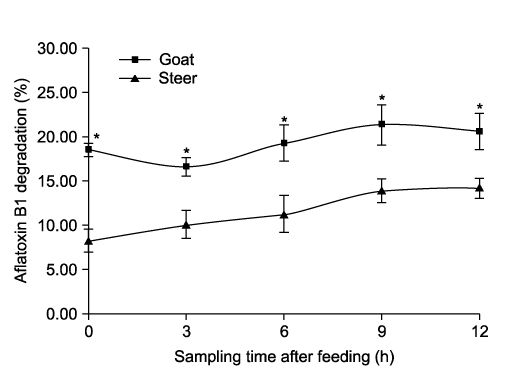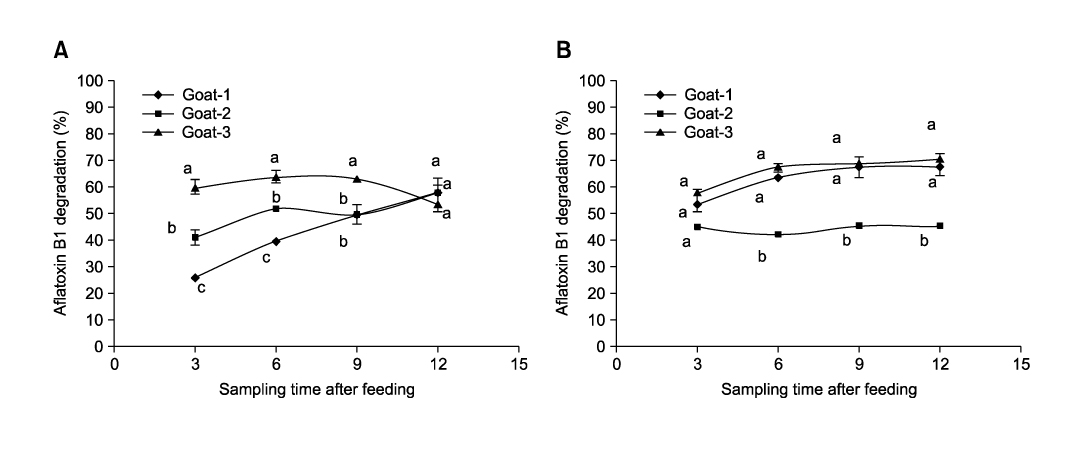J Vet Sci.
2009 Mar;10(1):29-34. 10.4142/jvs.2009.10.1.29.
Comparative study on the aflatoxin B1 degradation ability of rumen fluid from Holstein steers and Korean native goats
- Affiliations
-
- 1Department of Agricultural Biotechnology, Research Institute for Agriculture and Life Sciences, College of Agriculture and Life Science, Seoul National University, Seoul 151-921 Korea. jongha@snu.ac.kr
- 2Daeho Tech, Hwasung 445-933, Korea.
- 3GeneBio Tech, Gongju 314-831, Korea.
- KMID: 1089343
- DOI: http://doi.org/10.4142/jvs.2009.10.1.29
Abstract
- The aflatoxin B1 degrading abilities of two different ruminants were compared in this study. One set of experiments evaluated the aflatoxin B1 degradation ability of different rumen fluid donors (steers vs. goats) as well as the rumen fluid filtration method (cheese cloth filtered vs. 0.45 microm Millipore) in a 2 x 2 factorial arrangement. Additional studies examined aflatoxin B1 degradation by collecting rumen fluid at different times (0, 3, 6, 9 and 12 h) after feeding. Cannulated Holstein steers (740 +/- 10 kg bw) and Korean native goats (26 +/- 3 kg bw) were fed a 60% timothy and 40% commercial diet with free access to water. Rumen fluid from Korean native goats demonstrated higher (p < 0.01) aflatoxin B1 degradability than Holstein steers. However, filtration method had no significant influence on degradability. In addition, aflatoxin degradation did not depend upon rumen fluid collection time after feeding, as no significant differences were observed. Finally, a comparison of two types of diet high in roughage found aflatoxin degradability in goats was higher with timothy hay opposed to rice straw, although individual variation existed. Thus, our findings showed the aflatoxin degradability is comparatively higher in goats compared to steers.
Keyword
MeSH Terms
Figure
Reference
-
1. Allcroft R, Roberts BA, Lloyd MK. Excretion of aflatoxin in a lactating cow. Food Cosmet Toxicol. 1968. 6:619–625.
Article2. Brown T. Jordan FTW, Pattison M, editors. Fungal diseases. Poultry Diseases. 1996. 4th ed. London: Saunders;247–260.
Article3. Cheeke PR, Shull LR. Natural Toxicants in Feeds and Poisonous Plants. 1985. Westport: AVI Pub.;402–421.4. Craig AM, Blythe LL, Lassen ED, Slizeski ML. Resistance of sheep to pyrrolizidine alkaloids. Isr J Vet Med. 1986. 42:376–384.5. Craig AM, Pearson EG, Meyer C, Schmitz JA. Serum liver enzyme and histopathologic changes in calves with chronic and chronic-delayed Senecio jacobaea toxicosis. Am J Vet Res. 1991. 52:1969–1978.6. Diekman MA, Green ML. Mycotoxins and reproduction in domestic livestock. J Anim Sci. 1992. 70:1615–1627.7. Diener UL, Cole RJ, Sanders TH, Payne GA, Lee LS, Klich MA. Epidemiology of aflatoxin formation by Aspergillus flavus. Annu Rev Phytopathol. 1987. 25:249–270.8. Hooper PT. Keeler RF, Van Kampen KR, James LF, editors. Pyrrolizidine alkaloid poisoning-pathology with particular reference to differences in animal and plant species. Effects of Poisonous Plants on Livestock. 1978. New York: Academic Press;161–176.
Article9. Hult K, Teiling A, Gatenbeck S. Degradation of ochratoxin A by a ruminant. Appl Environ Microbiol. 1976. 32:443–444.
Article10. Jones FT, Wineland MJ, Parsons JT, Hagler WM. Degradation of aflatoxin by poultry litter. Poult Sci. 1996. 75:52–58.
Article11. Jones RJ, Megarrity RG. Successful transfer of DHP-degrading bacteria from Hawaiian goats to Australian ruminants to overcome the toxicity of Leucaena. Aust Vet J. 1986. 63:259–262.
Article12. Kallela K, Vasenius L. The effects of rumen fluid on the content of Zearalenone in animal fodder. Nord Vet Med. 1982. 34:336–339.13. Karlovsky P. Biological detoxification of fungal toxin and its use in plant breeding, feed and food production. Nat Toxins. 1999. 7:1–23.
Article14. Kiessling KH, Pettersson H, Sandholm K, Olsen M. Metabolism of aflatoxin, ochratoxin, zearalenone, and three trichothecenes by intact rumen fluid, rumen protozoa, and rumen bacteria. Appl Environ Microbiol. 1984. 47:1070–1073.
Article15. Kurmanov IA. Wyllie TD, Morehouse LG, editors. Fusariotoxicosis in cattle and sheep. Mycotoxic Fungi, Mycotoxins, Mycotoxicoses. 1977. Vol. 3. New York: Marcel Dekker;85–110.16. Marquardt RR. Effects of molds and their toxins on livestock performance: a western Canadian perspective. Anim Feed Sci Technol. 1996. 58:77–89.
Article17. Moss MO. Eley AR, editor. Mycotoxic fungi. Microbial Food Poisoning. 1996. 2nd ed. London: Chapman & Hall;75–93.
Article18. Nibbelink SK. Aflatoxicosis in food animals: a clinical review. Iowa State Univ Vet. 1986. 48:28–31.19. Phillips TD. Dietary clay in the chemoprevention of aflatoxin-induced disease. Toxicol Sci. 1999. 52:Suppl. 118–126.
Article20. Pier AC. Major biological consequences of aflatoxicosis in animal production. J Anim Sci. 1992. 70:3964–3970.
Article21. Schatzmayr G, Zehner F, Täubel M, Schatzmayr D, Klimitsch A, Loibner AP, Binder EM. Microbiologicals for deactivating mycotoxins. Mol Nutr Food Res. 2006. 50:543–551.
Article22. Sharma RP. Immunotoxicity of mycotoxins. J Dairy Sci. 1993. 76:892–897.
Article23. Wang RJ, Fui SX, Miao CH, Feng DY. Effects of different mycotoxin adsorbents on performance, meat characteristics and blood profiles of avian broilers fed mold contaminated corn. Asian-Aust J Anim Sci. 2006. 19:72–79.
Article24. Westlake K, Mackie RI, Dutton MF. In vitro metabolism of mycotoxins by bacterial, protozoal and ovine ruminal fluid preparations. Anim Feed Sci Technol. 1989. 25:169–178.
Article25. Whitlow LW, Haggler WM. Mycotoxin in feeds. Feedstuffs. 2004. 76:66–76.
- Full Text Links
- Actions
-
Cited
- CITED
-
- Close
- Share
- Similar articles
-
- The measurement of aflatoxin B in urine of some Korean
- Reduction in Binding of Aflatoxin B1 to Rat Liver DNA by Vitamin A and E Pretreatment
- Fine Structural Changes and Autoradiographic Studies of Rat Liver Cells Induced by Aflatoxin B1 and G1
- A study on the analysis of aflatoxin B in human sera by ELISA
- Detection of aflatoxin producing Aspergillus flavus from animal feed in Karnataka, India.



